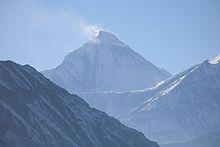Wojciech Kurtyka
Wojciech "Voytek" Kurtyka (born September 20, 1947 in Skrzynka (Lądek-Zdrój) , Powiat Kłodzki ) is a Polish mountaineer. Numerous first ascents in the Alps and the High Tatras , the Hindu Kush , but also in the Himalayas and Karakoram are among his greatest achievements. In 2016 Kurtyka was awarded the Piolet d'Or Lifetime Achievement, Walter Bonatti Award for his life's work.
Europe
Until 1974 Kurtyka was mainly traveling in the High Tatras, the Hindu Kush and the Alps. In 1974 he also carried out the first winter ascent of the Troll Wall , the highest steep face in Europe, in Norway. He also made several first ascents in the Alps, including one on the Petit-Dru north face in 1973. In 1975, together with Jerzy Kukuczka and Marek Łukaszewski, he set out on a new route on the Grandes Jorasses north face.
Himalayas and Karakoram
In 1975 Kurtyka took part in the first ever winter expedition to an eight-thousander . The goal was the Lhotse , but the summit could not be reached. A year later he was a participant in an expedition to K2 , where the east ridge was to be climbed for the first time. This expedition also failed, Kurtyka reached an altitude of approx. 7900 m .
After these great expeditions , Kurtyka only undertook alpine-style ascents in the Himalayas. He started doing it in 1978 when he and his climbing partner Alex MacIntyre set out on a new route up the Changabang .
In 1979 Kurtyka took part in a Polish expedition to the north side of the Dhaulagiri . The ascent failed, but Kurtyka discovered a possible route in the east face of the mountain while exploring. With a small team consisting of MacIntyre, the French René Ghilini and the Polish Ludwik Wilczyński, he returned to Dhaulagiri the following year. The climbers succeeded in the first ascent of the east face in alpine style, at an altitude of around 7500 meters they reached the northeast ridge after three days, bivouacked there again, but had to stop the further ascent due to stormy weather and descended over the ridge. A week later they climbed the north-east ridge to the summit, which they reached on May 18, 1980.
In 1981 he tried both in spring and autumn to climb Makalu over the west face, but failed both times. Together with Kukuczka, he climbed Broad Peak in alpine style . Neither of them had permission to climb this mountain, only one for the K2. This included climbing lower mountains for acclimatization , but not other eight-thousanders. During the descent they met Reinhold Messner , to whom they answered the question about the ascent that they had been 'in the area'. Messner understood and promised secrecy. Kurtyka and Kukuczka did not reach the summit of K2 this year. In the winter of the year Kurtyka and Messner failed at Cho Oyu .
In 1983 Kurtyka climbed both Gasherbrum II and Hidden Peak via new routes. He achieved one of his most important achievements in 1984 when he and Kukuczka crossed the northern, central and main summits of Broad Peak. The following year Kurtyka returned to Gasherbrum back, this time with Robert Schauer the Gasherbrum IV to climb a new route from the 2500 m high west wall. After eight days on the wall in partly stormy weather, they reached the summit ridge. Due to hunger, thirst and exhaustion, they decided not to use the traverse from the north to the main summit and immediately began the descent over the unclimbed north-west ridge, which took another three days. After Kurtyka failed in 1986 at the Nameless Trango Tower of the Trango Towers on the east side, he managed this ascent in 1988 together with Erhard Loretan . In 1987 and 1989 he failed again twice on the west wall of K2. After these failed ascents, Kurtyka climbed two more peaks with more than 8000 m height via new routes in 1990 with the Shisha Pangma Central and the Cho Oyu . He carried out both ascents with Loretan and Jean Troillet .
Until 1993 Kurtyka started new, difficult routes in the High Tatras, which are still among the most difficult in the region. In 1993 he wanted to commit a new route to Nanga Parbat over the Manzeno ridge together with Doug Scott , but Scott injured himself before attempting the first ascent. In the following year Kurtyka failed again on the west wall of K2. Another attempt on the Manzeno ridge of Nanga Parbat in 1997, this time together with Loretan, failed again.
Between 1996 and 2002 Kurtyka failed several times on the north face of Khan Tengri . Since then he has been working more on shorter sport climbing routes. At the age of 56, in 2003, he climbed a route rated 8a (French) .
Web links
- Short biography on www.bergfieber.de
- Detailed description of Kurtyka's ascents on www.climbandmore.com (English)
Individual evidence
- ↑ Piolets d'Or Lifetime Award. Honor for Wojciech Kurtyka. Alpin , March 9, 2016, accessed October 14, 2016 .
- ↑ a b Ascent of Kurtyka until 1980, accessed on January 7, 2009
- ↑ Alex MacIntyre: Dhaulagiri's East Face. In American Alpine Journal 1981, pp. 45-50. (AAJO) (PDF; 1.3 MB), accessed on October 9, 2012.
- ^ Wojciech Kurtyka: The Shining Wall of Gasherbrum IV. In: American Alpine Journal 1986 (AAJO). , accessed October 9, 2012.
- ↑ ascents Kurtykas to 1990, access January 7, 2009
- ↑ a b Ascent of Kurtyka up to 2003, accessed on January 7, 2009
| personal data | |
|---|---|
| SURNAME | Kurtyka, Wojciech |
| ALTERNATIVE NAMES | Kurtyka, Voytek |
| BRIEF DESCRIPTION | Polish climber |
| DATE OF BIRTH | September 20, 1947 |
| PLACE OF BIRTH | Skrzynka (Lądek-Zdrój) , Powiat Kłodzki |
